Abstract
Due to the increased role of digital texts both in everyday communication and education, the case of the teachers’ ability to maintain the educational process taking into account new realities turns out to be relevant. In the professional competencies’ structure of a Russian language teacher, an important place is taken by the ability to teach working with digital multimodal. Currently, the question of how this skill is formed by teachers of the Russian language is not sufficiently studied. This article tries to fill this lacuna: it is devoted to the practice study of using digital texts in teaching the Russian language. The sample of the research was 146 Russian language teachers in Russia and abroad. In general the results of the research showed – teachers intuitively understand the differences in digital and paper formats and their impact on the process and reading results. The didactic potential of these texts is recognized by teachers, and they quite actively use digital texts in the educational process, but most often – ready or adapted. At the same time, the research showed teachers tend to rely on intuition – their own and students – while working with digital texts. However, international studies show such an approach is not effective enough. It raises the question of existing deficits in modern educational practices and ways to fill them.
Keywords: Digital texts, digital literacy, digital reading, multimodality, teacher's’ digital competence
Introduction
Obtaining information from the text located on the screen – digital reading – takes an increasing place in the communicative practices of a modern person, including a pupil and a student. It is partly due to the digital transformation of education, which inevitably leads to an increase in the digital educational resources with which students interact in and out of school. It is obvious that digital texts, compared to paper media, have a number of distinctive features – these features determine the nature of digital reading.
In this regard, the need for training in working with digital texts seems expedient. Research shows the strategies of a child's interaction with digital text are formed largely due to the influence of an adult teaching him to read – using an adult’s example (Kucirkova & Littleton, 2016) or explicitly during special classes (Davies & Merchant, 2009; Walsh, 2010). Such an adult, of course, could and should be a school teacher who has a sufficient level of digital literacy and consciously uses digital texts in his professional and everyday life. The ability to effectively use digital resources including in the teacher's professional standard requires the teacher himself to understand the features of digital text and digital reading.
Problem Statement
Due to the concept of multimodal literacy, the literacy concept is being rethought: it is not only the ability to write and read, but the ability to use the entire repertoire of different semiotic systems to understand and convey meaning (Kress, 2003). Thus, it is recognized that in the process of learning, a student must learn to determine, interpret and evaluate information from texts of various nature, as well as express his thoughts and feelings using texts of various nature. In a range of countries, the theory of multimodal literacy has significantly influenced educational programs: consistent and systematic work with digital texts is enshrined in the national educational standards of Finland (The Finnish National Board of Education), the USA (The Common Core State Standards for English Language Arts & Literature in History), Australia (Australian Curriculum). It made necessary to update the training programmes for Russian language teachers, who should be ready for the formation of literacy and competencies relevant to modern realities (Luke et al., 2017).
Obviously, to effectively teach interaction strategies with digital multimodal texts, a teacher must have the appropriate competencies, and they must be more developed more than students’ competencies. However, it is now widely spread the so-called «digital natives» (Prensky, 2001), that is, people born after 1984, have a natural ability to use Internet technologies, a multi-tasking skill, while the «digital immigrants» teaching them do not have sufficient knowledge and skills in the sphere of modern technologies and cannot teach digital natives. Despite a sufficient number of research confirming the existence of a digital gap between generations in the educational environment, a range of recent research refuse this provision (Romero et al., 2013; Wang et al., 2014). Kennedy and Fox (2013) found students mainly use technology for «personal empowerment and entertainment, but not always digitally literate in using technology to support their learning». A similar survey among Russian teachers showed similar results: it turned out «school teachers are significantly ahead of their students in all aspects of digital literacy, except for attitudes to innovation, – teenagers 12-17 years old are actively using modern gadgets and technologies in everyday life, they could easily understand the use of technological innovations» (Aymaletdinov et al., 2019). The review Kirschner and De Bruyckere (2017) confirms that though learners in this generation have only experienced a digital connected world, they are not capable of dealing with modern technologies in the way which is often ascribed to them (i.e., that they can navigate that world for effective and efficient learning and knowledge construction). In this regard, the authors emphasize, it is important to pay attention not so much to the research of cognitive differences between generations, but to the design of a digital educational environment in which the teacher with their knowledge and skills in the domain that they teach, the pedagogy for that domain (i.e., pedagogical content knowledge) and the pedagogy using digital tools and media (i.e., technological pedagogical content knowledge) (Kirschner & De Bruyckere, 2017).
Regarding the ability of teachers to work with digital texts and teach these skills to schoolchildren and students, it is necessary to mention the concept of «digital competence». The concept of «digital competence» was officially established in 2006 by the European Parliament and the Council – digital competence was recognized as necessary for active civil and public life (Recommendation of the European Parliament and the Council of 18 December 2006 on key competencies for lifelong learning). Later in 2013, the European Commission developed the European Framework for Digital Competencies – The European Digital Competition Framework (DigComp). Based on this document, a digital literacy framework for teachers has been developed in a number of countries (Norway (Krumsvik, 2011), Turkey (Hasar, 2019). The key concept in such documents is the digital competence of the teacher – a competence allowing the teacher to develop the digital skills of students through working with educational material (Ottestad et al., 2014).
Krumsvik (2007, as cited in Ottestad et al., 2014) defines digital competence specifically for teachers: «Digital competence is the ability of a teacher to use ICT with a good pedagogical and didactic understanding of ICT and to realize how it could affect learning strategies and educational training of students» (p. 68). It means the teacher must make decisions which digital tools should be used in each educational situation, how they should be used and why.
In Russian-language education, the «digital shift» in teaching literature and language has not yet been systematically integrated into the educational system. The regulations contain only general requirements for the formation of ICT competencies of schoolchildren, for example, in Federal State Educational Standard for primary school (Federal State Educational Standard for primary school 2009) it is written using various methods of searching (in reference sources and open educational information of the Internet), collecting, processing, analyzing, organizing, transmitting and interpreting information in accordance with communicative and cognitive tasks and technologies of the educational subject, and the secondary school curriculum (Federal State Educational Standard for secondary school 2010) should provide developing and forming the competence of students in the use of information and communication technologies at the public level. At the same time, at the level of individual cases, it is noticeable some teachers realize the importance of including digital texts into real educational practice. The didactic potential of digital multimodal texts, the features of interpreting and creating multimodal texts are discussed by teachers and methodologists on specific examples (Melentieva, 2019; Romanicheva, 2020). Monitoring conducted in 2019 by National Financial Research Agency (NAFI), a multidisciplinary analytical center, showed in general Russian teachers – both school teachers and university teachers – have a high level of digital literacy – the digital literacy index significantly exceeds the average Russian level (by 35 pp) and amounts to 87 pp among school teachers and 88 pp among university teachers (out of 100 possible) (Aymaletdinov et al., 2019).
“The Digital educational environment” project (as part of the “Education” national project), which has been launched in the Russian Federation since 2019, has been aimed at developing the professional ICT competence of teachers. In this regard, researchers Zeer et al. (2020) emphasize literacy needs to be reviewed in the context of current curricula, especially in the light of the national curriculum emergence. It has become clear language and literacy processes in conversation, auditing, reading and writing embody additional dimensions in combination with digital communications technologies.
Separately, the need to revise the principles of teaching to read digital texts should be noted. Researches in the sphere of digital reading show the process of reading from the screen is different from reading from a sheet. It is noted the leading strategies for reading from the screen are viewing, scanning, keyword search (Liu, 2005), in addition, additional mechanisms are connected: information search and verification strategies, as well as assessments of the relevance and reliability of the found information (Green et al., 2010; Santana et al., 2011). Changing screen reading strategies certainly affects not only the process itself, but also the reading results. As a result of the analysis of researches comparing reading from the screen with reading a sheet, conflicting information was found: a range of scientists came to the conclusion the understanding of what was read during digital reading is worse (Golan et al.2018; Halamish & Elbaz, 2020; Støle et al., 2020), another part claims the digital format improves understanding (McCrea-Andrews, 2014; Pomplun et al., 2002), there were no differences or the size of the effect was insignificant in some works (Hermena et al., 2017; Porion et al., 2016). A review of digital reading studies showed the importance of conscious choice of format depending on the tasks of training of the ability to extract information from different components and synthesize meaning from different sources, optimally determine the reading path of non-linear text, and effectively use the interactive capabilities of digital text (Lebedeva et al., 2020). Taking into account the features of digital reading is extremely important while teaching digital literacy to students.
Research Questions
In this research, we formulated three research questions:
RQ1. How well do teachers understand the features of digital texts and the peculiarities of digital reading?
RQ2. How do teachers work with digital texts: how do they exactly use digital texts, in what conditions and for what tasks?
RQ3. How are teachers involved in digital communication and digital reading processes in everyday and professional life?
Purpose of the Study
The aim of the research is to identify the ability degree of modern teachers to use digital texts in pedagogical practice, determine the current level of knowledge of the features and restrictions of digital reading affecting the depth of the text comprehension, as well as the study of reading behavior in the digital environment of teachers themselves.
Research Methods
For the research, a questionnaire was developed aimed at researching the experience of using digital texts in education. The research consisted of four blocks of questions: the first block made it possible to draw up a portrait of the respondent (gender, age, region, subjects taught, work experience), the second block contained questions about the use of digital texts in teaching, the third block was aimed at determining the degree of teachers’ familiarity with the features and limitations of digital reading, the fourth block was designed to identify the reader's behavior of the teacher in the digital environment.
The questionnaire was conducted in April-May 2020. In total, 146 teachers of secondary and higher educational institutions took part in the research, most of them teach philological disciplines. At the same time, a little more than half of the respondents teach only Russian as their native language (52,1%), the rest of the respondents have experience in teaching Russian as a foreign or second language.
Most of the research participants work in Russia, the sample is based on representatives of the following regions: Moscow, Novorossiysk, Novosibirsk, Tyumen, St. Petersburg, Nizhny Novgorod, etc. About a third of respondents (27,9%) represent other countries (Spain, Georgia, Italy, Kazakhstan, Slovakia, Ukraine, the USA, Latvia, the Netherlands, Austria, Belarus, Kazakhstan, Serbia, China, etc.).
After the questionnaire, quantitative and qualitative analysis of the obtained information was carried out.
Findings
Teachers’ understanding of digital text functioning
To determine how deeply teachers understand the specifics of screen reading, respondents were asked to note the features of digital texts which unambiguously distinguish them from paper analogues. An analysis of the answers suggests teachers are generally aware of the differences between digital and paper texts. So, most teachers, following the researchers of the digital reading phenomenon, noted the features of digital texts are interactivity (73,3%), nonlinearity (61%), significant information is transmitted through illustrations (51,4%), the reader himself chooses how to read the text (53,4%). At the same time, a significant part of respondents noted as a feature of digital text a small volume (26,7%) and non-compliance with grammatical and stylistic norms (22,6%), which may characterize digital text, but are not its specific properties.
The answers to the question «What kind of reading do you think is characteristic of digital texts» also confirm the conclusion most teachers understand how a person reads from the screen: 45,2% noted search reading, 28,1% introductory, 23,3% viewing and only 3,4% – studying. It is worth noting the type of reading largely depends on the introduction into reading, however, the general reading strategies and patterns identified by researchers traditionally do not include studying reading, online reading is characterized by viewing and skimming – it is «intermittent and often fragmented reading», unlike concentrated reading of paper books (Hillesund, 2010).
Based on the results of these two questions, we could draw conclusions about teachers' acquaintance with digital reading and assume modern teachers, realizing the transformation of communicative reality, purposefully study scientific and methodological literature devoted to digital reading. However, the question «Do you think it is necessary to take into account digital reading strategies while preparing materials for the lesson?» shows almost half of teachers (44,5%) believe «it is possible to act intuitively, since they are constantly in a digital environment and feel how to work with digital texts», and 17,8% of respondents think extensive experience with paper texts will allow teachers to teach and read screen texts, and answer «it's good enough to know how to work with paper texts, and build on this knowledge to work with digital materials» (see Figure 1). At the same time, as we noted above, students are not proficient in technology at the level which is attributed to them, especially they cannot sufficiently understand and control such a complex process as the digital reading process, so the teacher’s role in teaching strategies for effectively extracting information from the text on the screen is decisive.
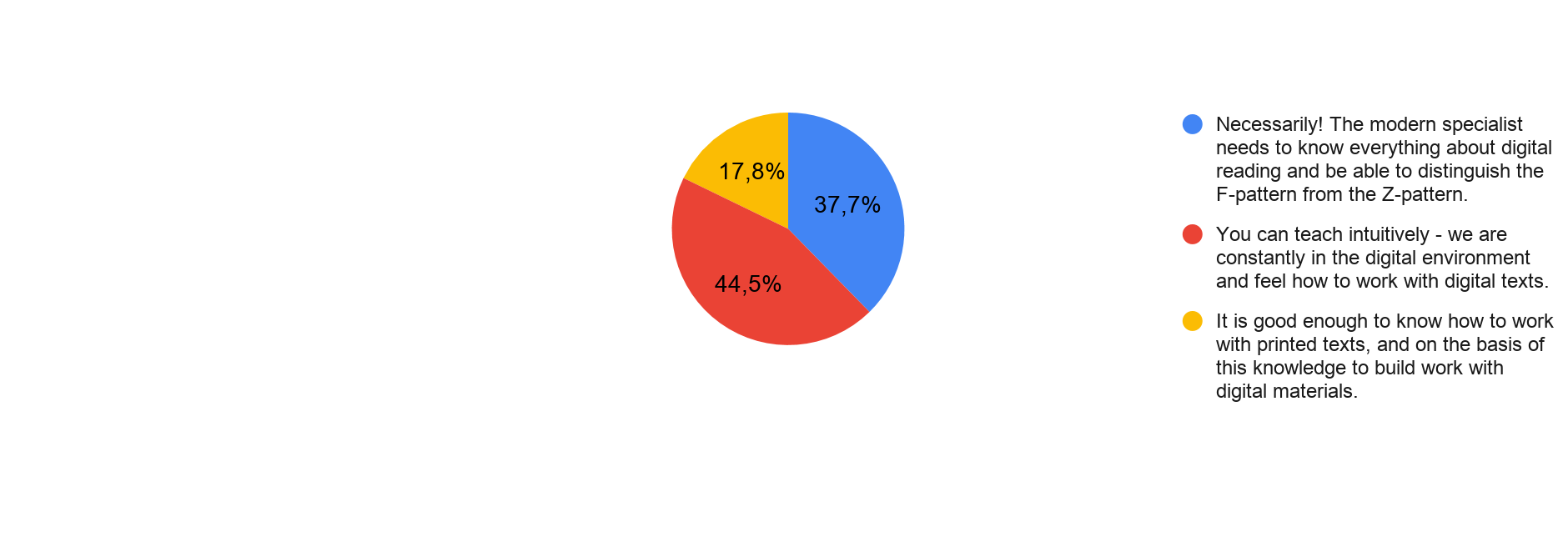
In teaching, it is important not only to understand the features of the new phenomenon, but also to feel how children perceive new types of texts to effectively build work with them. Table 1 shows a comparison of the results of this study with our survey of children (568 students of grades 5-11 from 54 regions of the Russian Federation took part in the survey). Some differences between reading self-reflection of children and teacher assumptions were revealed. So, children do not feel the difference among formats in reading results, namely in the speed of reading and memorizing information, and teachers assume the paper format wins in speed and as a memorization in digital. Also, for children, there is no difference between reading from the screen and from the sheet in terms of interest in reading, and teachers suggested children quickly lose interest in reading in digital format. Note the listed differences in the responses of children and teachers show the excessive concern of teachers regarding the quality of digital reading, while for children this difference is not obvious.
Use of digital texts in teaching Russian
The next block of questions reveals exactly how teachers work with digital texts. The question «How often do you give students the following types of tasks?» showed the frequency of tasks using digital texts differs significantly depending on the task type (see Figure 2). So, teachers offer tasks for making texts in a digital environment and searching and processing information in the Internet to students quite regularly, and most teachers do not include the task of making web pages and writing posts on social networks in the educational process. At the same time, the bulk of the communication of a modern child takes place directly in the digital environment, and the skills of maintaining competent digital texts, synthesizing information from various Internet sources, assessing the reliability of information found on the network should be developed, including within the framework of school classes. The latest reading literacy research within PISA monitoring, which examined reading from the screen, showed for Russian schoolchildren, the most difficult tasks are to identify and analyze contradictions and assess the quality and reliability of information (In what direction is it developing Russian general education system? (according to the results of the international program PISA-2018). The authors of the report explain the low results of completing tasks for checking these reading skills by the fact these skills are not the subject of the teachers’ work. In addition, the educational process does not consider many types of texts from everyday life which are included in the PISA research: advertising, texts of ads, chats, online forums, etc. Insufficient attention is paid to working with information in the electronic environment: sorting it by relevance, assessing the quality and reliability of sources, refining the information request, etc. The strategy of digitalization of education in Russia is aimed at solving the problem of insufficient inclusion of electronic materials in the educational process, which implies the use of modern technologies in the implementation of basic educational programs.
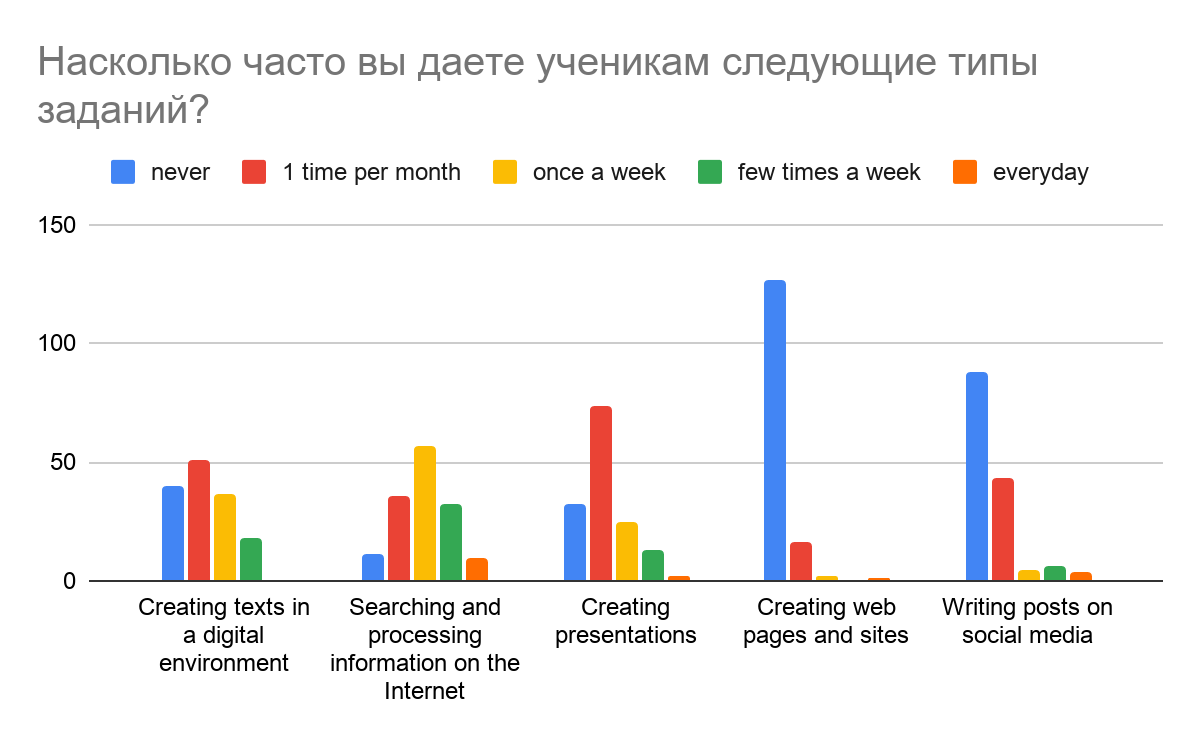
The curious results were shown by the question «How often do your students work with digital texts as part of tasks in lessons and as part of homework?» – it turned out students do such work more often at home, which may be due to insufficient technical equipment for classrooms in schools and universities, as well as with more time required to complete tasks containing digital texts (see Figure 3).
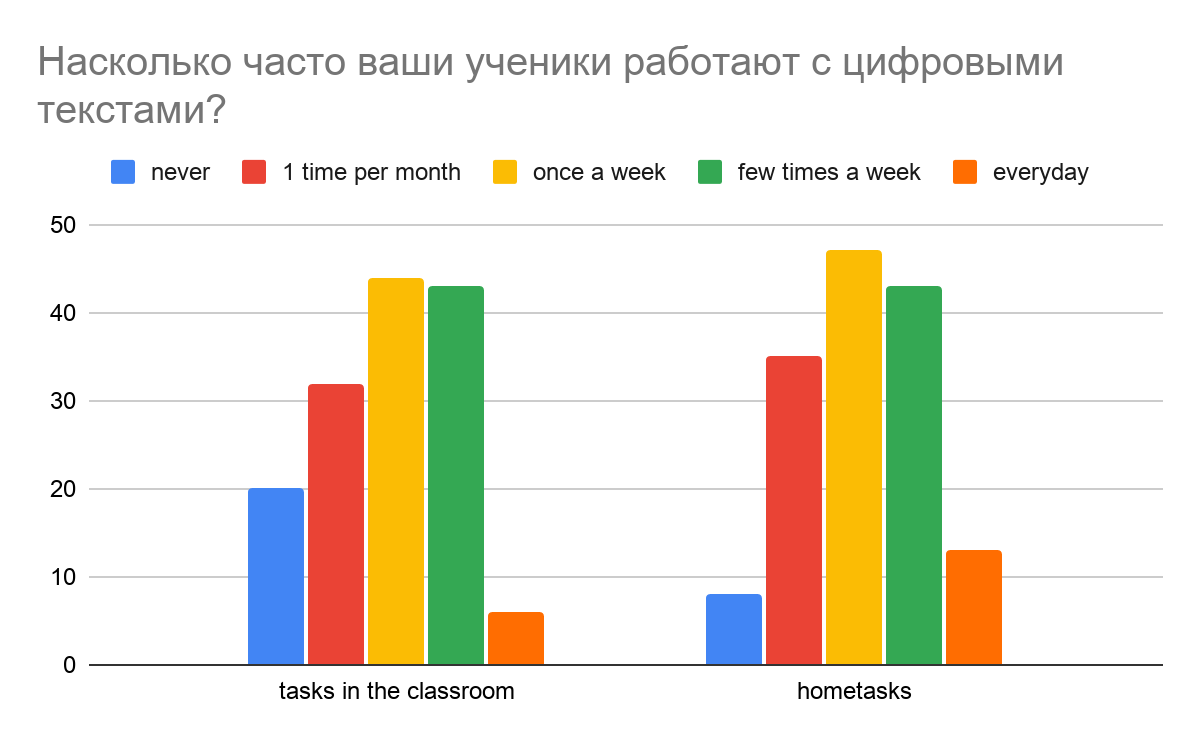
In the research, we were interested in identifying the most common way for teachers to prepare digital materials. The results of the survey showed teachers who include digital texts in classes most often adapt texts from the Internet, less than a quarter of teachers make texts from scratch (23,4%). At the same time, there is no significant difference in the results among teachers of the Russian language as a native language and the Russian language as a non-native/foreign language. According to our hypothesis, teachers of Russian as a non-native/foreign language should use adapted digital materials more often, since they are faced with the task of reworking ready-made texts in accordance with the level of language proficiency of students. But it was found that teachers of the Russian language as a native language also often adapt texts from the Internet, which may indicate ready-made online texts do not have the necessary educational potential and require adjustment.
As for the digital genres teachers include in the educational process, Figure 4 shows distribution of types of information visualization in teaching practice. Аccording to the research results, most often teachers use classical genres and formats (presentations, tables, charts and diagrams) in educational activities. Actual authentic genres and formats, which environment is mainly the Internet, for example, infographics, wordclouds , memes, are beginning to gain popularity in the teaching environment. The least popular are digital lonform and whiteboard animation, which have only recently come to teaching methods and do not yet have developed methodological recommendations for use in classes.
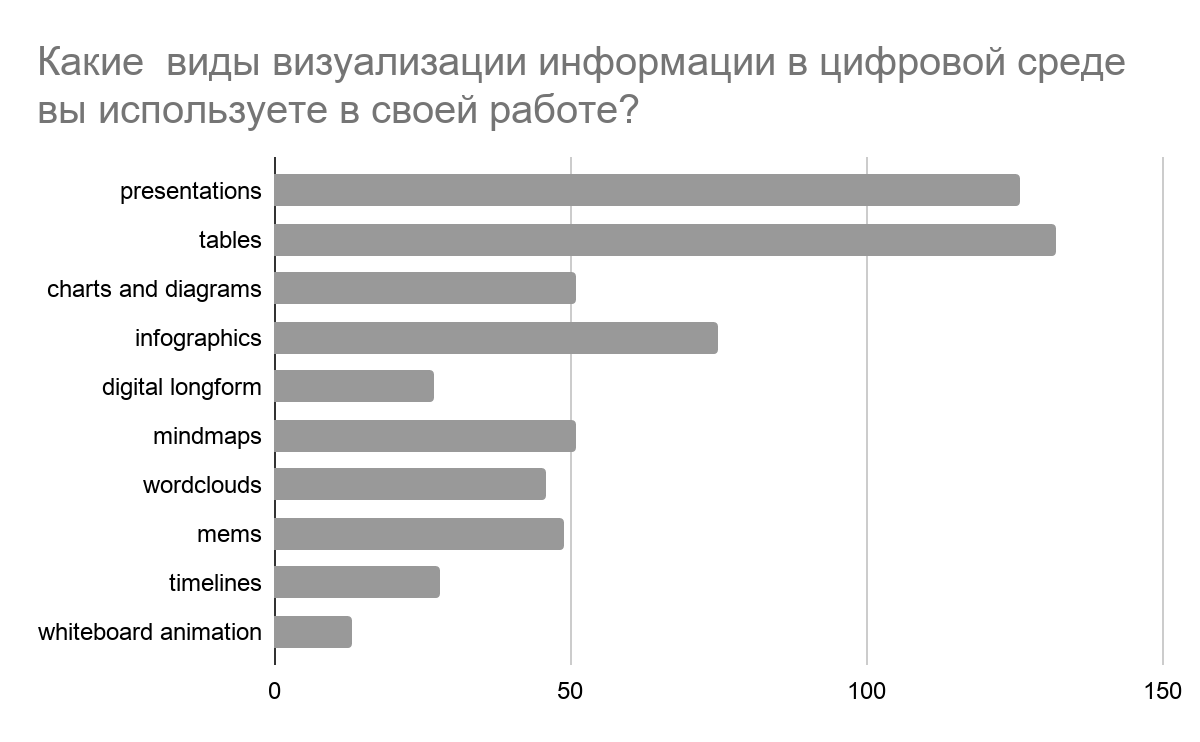
Teachers’ reading behaviour and digital reading habits
The final block of the research was devoted to the reader's behavior of the teacher. The purpose of this block of questions was to find out how much teachers are involved in communication in the digital environment and digital reading processes. The question «What social networks do you use» showed teachers widely use social networks, but it can be noted only a small part of respondents mentioned TikTok and Telegram, which are one of the most popular today among children and adolescents (see Figure 5). At the same time, it should be emphasized most of the popular social networks among teachers belong to the so-called text social networks, which are dominated by written verbal content (Vkontakte, Facebook, Whatsapp), which may indicate teachers regularly meet text information in the Internet.
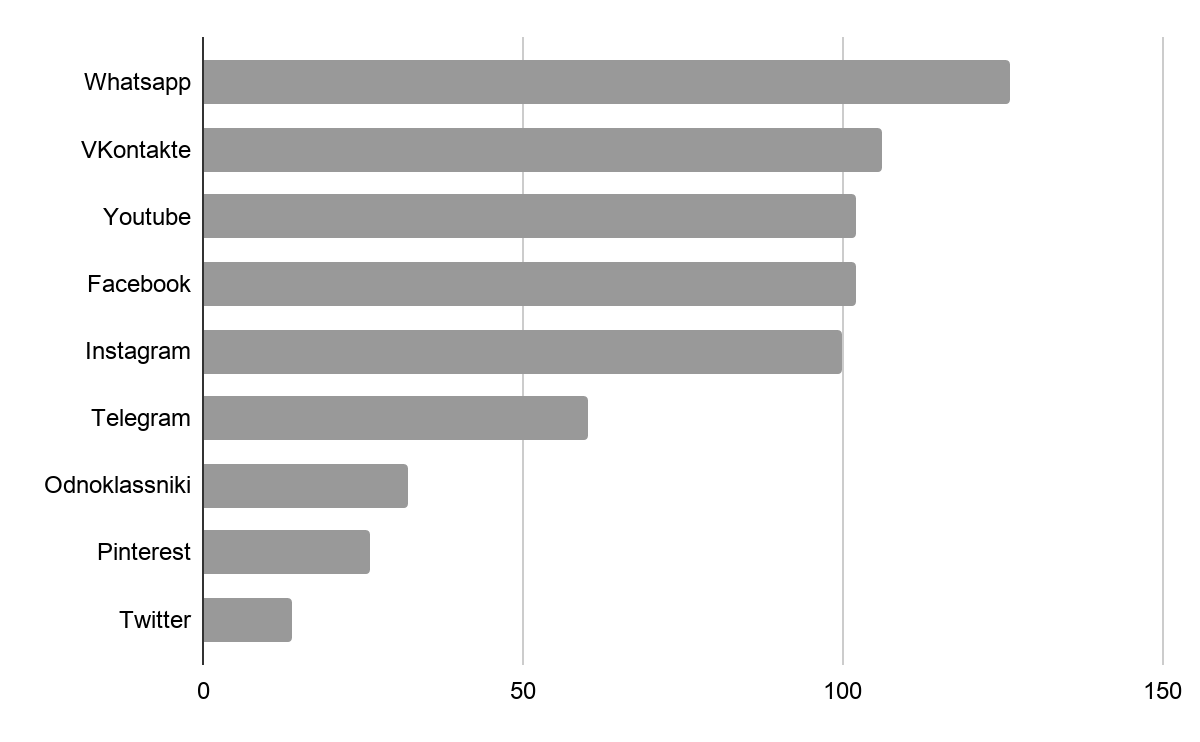
Figure 6 shows what gadgets teachers use: a stationary personal computer or laptop takes the leading position – 95,2% of respondents noted they use it often. The smartphone lags behind by several percent: it is regularly used by 91,7%. This ratio differs significantly from the situation among schoolchildren: only 54% schoolchildren often use a stationary personal computer or laptop when 91,7% often using a smartphone.
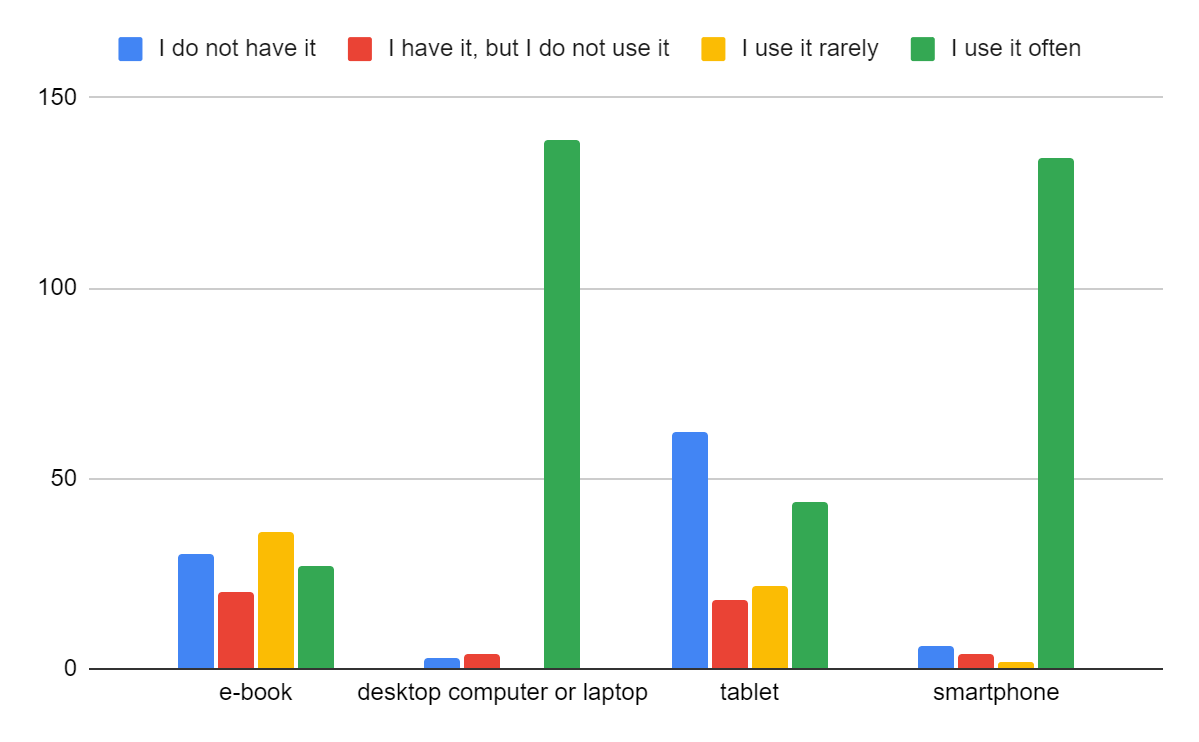
The difference between teachers and schoolchildren is also observed in the question of the preferred reading format (see Figure 7). Among schoolchildren, the most common medium used for reading is a smartphone (63% of students read from it most often), reading a printed book ranks second in popularity. Teachers put a paper book in first place, which determined reading from the smartphone screen by almost 10 percent (59,5% noted they very often read a paper book, 50% – a smartphone). Reading from the tablet screen and reading an e-book are equally unpopular with both teachers and schoolchildren.
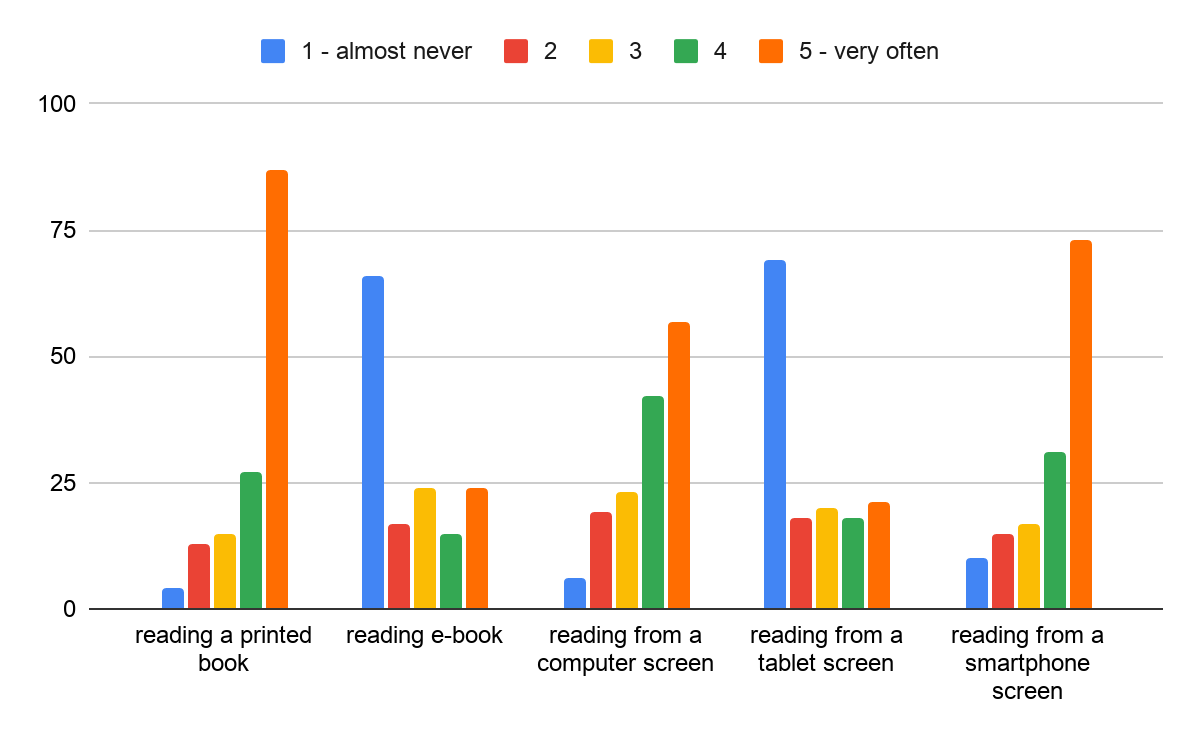
In Figure 8 the reading preferences of teachers depending on the content and genre of the digital text are presented. The survey showed most often in digital format teachers read news and entertainment content, for artistic texts preference was unequivocally given to paper format. As for academic materials, the answers were distributed approximately equally, teachers use both formats to read materials for work and scientific articles to the same extent. Such results relate to experimental studies, which show voluminous academic texts are difficult to perceive electronically, but the speed and volume of access to information seems to play in favor of the digital format.
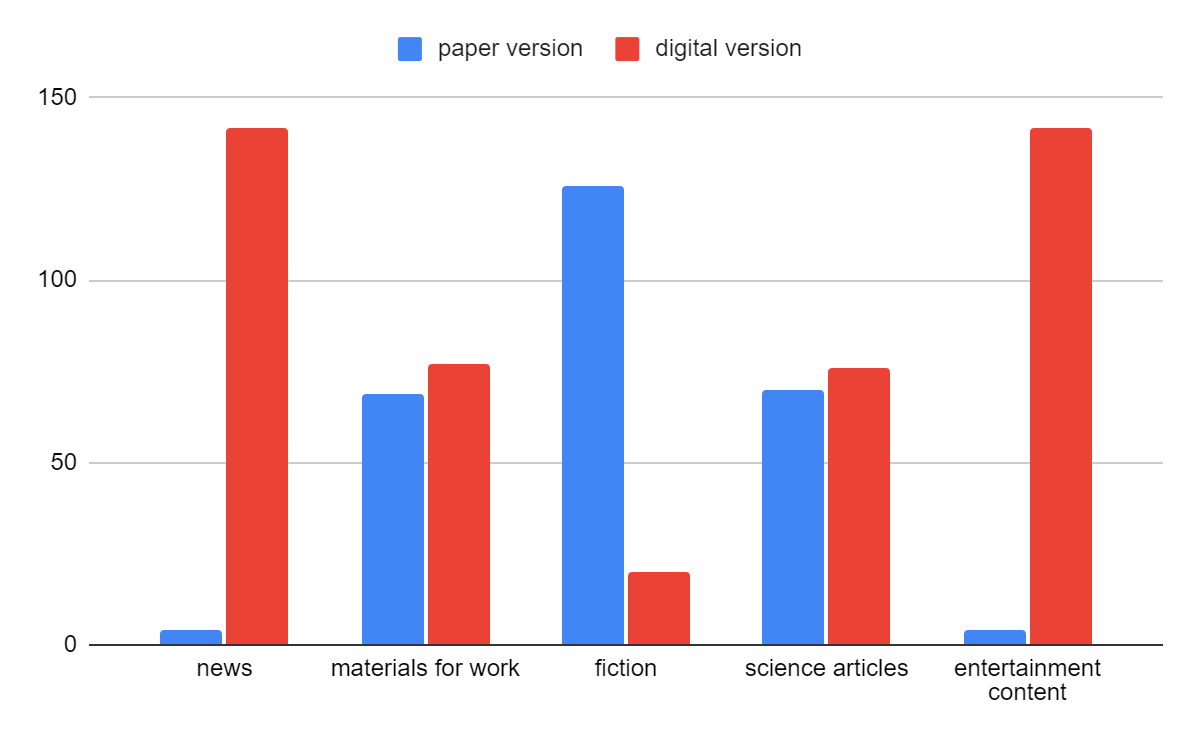
The question «Why do you use Internet resources in your professional activities?» showed teachers most often use Internet sources to prepare for classes (94,5%), while it is important to note a high percentage of teachers resort to certain sites to verify information in which they doubt (89%). Most often, respondents communicate in professional communities on the Internet (69,9%) (see Figure 9).
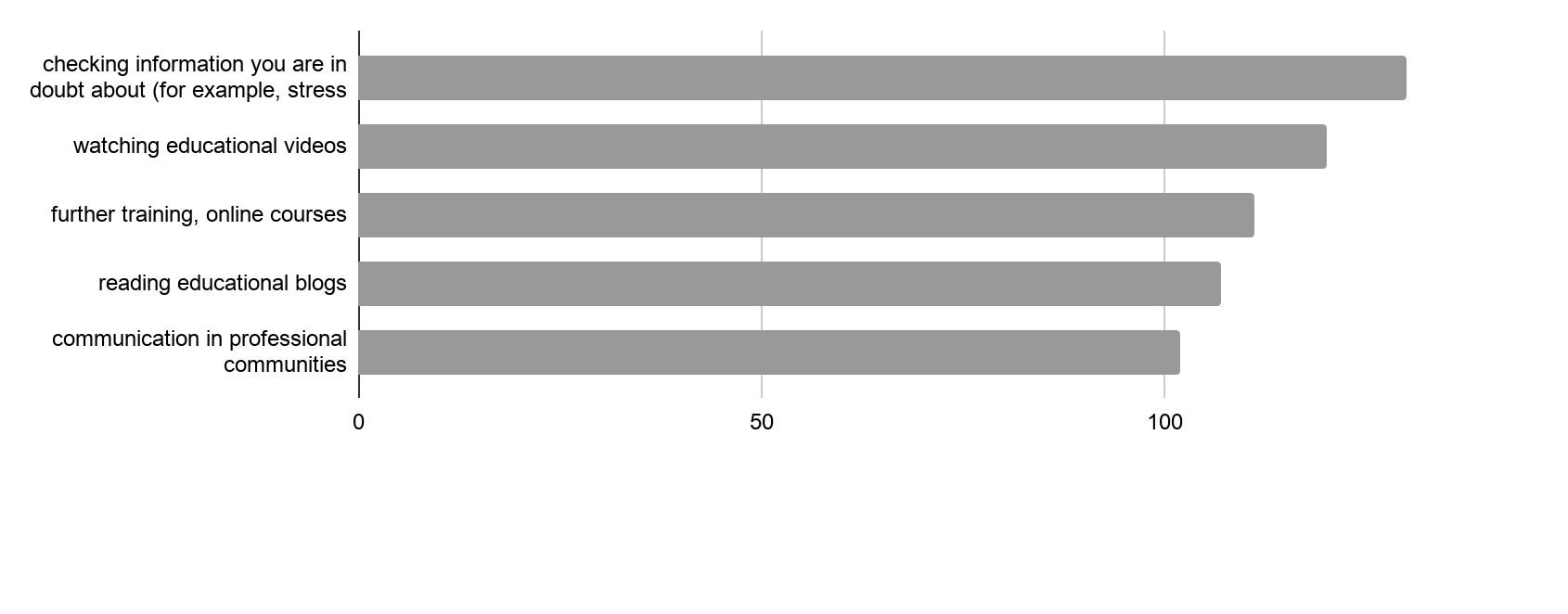
Conclusion
The research showed digital texts in general take an important place in the practice of teaching Russian and teachers are aware of the didactic potential of these texts.
Teachers themselves actively participate in communication in the digital environment, and digital reading as a special practice is common in the everyday and professional life of a teacher. The research showed teachers widely use social networks, but their repertoire differs from social networks, the most popular today among children and adolescents. More often, teachers use the so-called text social networks.
The active presence in the digital environment leads to a generally high level of understanding by teachers of the digital texts and digital reading’s specifics. Teachers accurately determine the differences between digital and paper texts and quite actively include these digital texts in the educational process. Teachers often offer students tasks for making texts in a digital environment and searching and processing information in the Internet teachers and quite regularly. Less popular are tasks on making web pages and writing posts in social networks. In general, digital text is included in homework rather than in the lesson.
The research showed the teachers’ ability to independently make digital texts for educational purposes, but more often teachers use ready-made texts from the Internet or adapt them. Nevertheless, even the selection and adaptation of digital texts require the teacher to know the features of digital reading.
At the same time, the research showed teachers tend to rely on intuition – their own and students – while working with digital texts; only a third of respondents believe that it is important to take into account the specifics and limitations of the digital format and purposefully form effective digital reading strategies. However, international studies show some aspects of reading literacy are not sufficiently developed among Russian schoolchildren – in particular, due to the fact this development of some relevant skills is not included in the tasks of Russian language teachers. Of course, it raises the question of the existing deficits in modern educational practice and ways to overcome them.
Acknowledgments
The reported study was funded by RFBR, project number 19-29-14148 «Text in a digital learning environment: research on Russian school children’s reading strategies and factors affecting the quality of digital reading»
References
Australian Curriculum, Retrieved on May 25, 2020, from https://www.australiancurriculum.edu.au/f-10-curriculum/english/key-ideas/
Aymaletdinov, T. A., Baymuratova, L. R., Zaytseva, O. A., Imayeva, G. R., & Spiridonova, L. V. (2019). Digital literacy of Russian teachers. Readiness to use digital technologies in the educational process [Tsifrovaya gramotnost'rossiyskikh pedagogov. Gotovnost'k ispol'zovaniyu tsifrovykh tekhnologiy v uchebnom protsesse]. Analytical Center NAFI.
Davies, J., & Merchant, G. (2009). Web 2. 0 for Schools: Learning and Social Participation. Peter Lang.
Federal State Educational Standard for primary school: approved by order of the Ministry of Education and Science of the Russian Federation dated October 6, 2009, № 373. Ministry of Education and Science of the Russian Federation, Moscow, 2009.
Federal State educational standard for secondary school: approved by order of the Ministry of Education and Science of the Russian Federation of December 7, 2010, № 1897. Ministry of Education and Science of the Russian Federation, Moscow, 2010.
Golan, D. D., Barzillai, M., & Katzir, T. (2018). The effect of presentation mode on children's reading preferences, performance, and self-evaluations. Computers & Education, 126, 346-358.
Green, T. D., Perera, R. A., Dance, L. A., & Meyers, E. A. (2010). Impact of Presentation Mode on Recall of Written Text and Numerical Information: Hard Copy Versus Electronic. North American Journal of Psychology, 12(2), 233-242.
Halamish, V., & Elbaz, E. (2020). Children's reading comprehension and metacomprehension on screen versus on paper. Computers & Education, 145.
Hasar, E. (2019). A Comparison between European Digital Competence Framework and the Turkish ICT Curriculum. Online Submission, 7(4), 954-962.
Hermena, E. W., Sheen, M., AlJassmi, M., AlFalasi, K., AlMatroushi, M., & Jordan, T. R. (2017). Reading rate and comprehension for text presented on tablet and paper: Evidence from Arabic. Frontiers in psychology, 8, 257.
Hillesund, T. (2010). Digital reading spaces: How expert readers handle books, the Web and electronic paper.
In what direction is it developing Russian general education system? (according to the results of the international program PISA-2018). Ministry of Education of the Russian Federation Institute of education development strategy Russian Academy of Education, Education Quality Assessment Center, Moscow, 2018.
Kennedy, D. M., & Fox, R. (2013). ‘Digital natives’: An Asian perspective for using learning technologies. International Journal of Education and Development using ICT, 9(1), 65-79.
Kirschner, P. A., & De Bruyckere, P. (2017). The myths of the digital native and the multitasker. Teaching and Teacher Education, 67, 135-142.
Kress, G. R. (2003). Literacy in the new media age. Psychology Press.
Krumsvik, R. J. (2011). Digital competence in the Norwegian teacher education and schools. Högre Utbildning, 1(1), 39-51.
Kucirkova, N., & Littleton, K. (2016). The digital reading habits of children: A national survey of parents’ perceptions of and practices in relation to children’s reading for pleasure with print and digital books.
Lebedeva, M. Yu., Veselovskaya, T. S., & Kupreshchenko, O. F. (2020). Features of perception and understanding of digital texts: interdisciplinary view [Osobennosti vospriyatiya i ponimaniya cifrovyh tekstov: mezhdisciplinarnyj vzglyad]. Perspectives of Science & Education, 46(4).
Liu, Z. (2005). Reading behavior in the digital environment. Journal of documentation, 61(6), p. 700-712.
Luke, A., Sefton-Green, J., Graham, P., Kellner, D., & Ladwig, J. (2017). Digital ethics, political economy and the curriculum: This changes everything. In K. Mills, A. Stornaiuolo & J. Pandya-Zacher (Eds.), Handbook of Writing, Literacies and Education in Digital Culture. Routledge.
McCrea-Andrews, H. J. (2014). A Comparison of Adolescents' Digital and Print Reading Experiences: Does Mode Matter?.
Melentieva, Yu. P. (2019). Digital reading for teaching and learning [Chtenie elektronnyh publikacij kak element obucheniya i obrazovaniya]. Scientific and Technical Libraries, (4), 76-83.
Ottestad, G., Kelentrić, M., & Guðmundsdóttir, G. B. (2014). Professional digital competence in teacher education. Nordic Journal of Digital Literacy, 9(04), 243-249.
Pomplun, M., Frey, S., & Becker, D. F. (2002). The score equivalence of paper-and-pencil and computerized versions of a speeded test of reading comprehension. Educational and psychological measurement, 62(2), 337-354.
Porion, A., Aparicio, X., Megalakaki, O., Robert, A., & Baccino, T. (2016). The impact of paper-based versus computerized presentation on text comprehension and memorization. Computers in Human Behavior, 54, 569-576.
Prensky, M. (2001). Digital natives, digital immigrants. On the horizon, 9(5).
Recommendation of the European Parliament and the Council of 18 December 2006 on key competencies for lifelong learning. Brussels: Official Journal of the European Union, 30(12), 2006.
Romanicheva, E. S. (2020). News Text on Paper and on Screen: Reading Strategies. Moscow: Russian Reading Association [Novostnoj tekst na bumage i na ekrane: strategii chteniya]. Human reading: Homo legens-12, 2020, p. 178.
Romero, M., Guitert, M., Sangrà, A., & Bullen, M. (2013). Do UOC students fit in the Net generation profile? An approach to their habits in ICT use. International Review of Research in Open and Distributed Learning, 14(3), 158-181.
Santana, A. D., Livingstone, R., & Cho, Y. (2011). Medium matters: Newsreaders’ recall and engagement with online and print newspapers. In Annual meeting for Association for Education in Journalism and Mass Communication, Newspaper Division (Vol. 10).
Støle, H., Mangen, A., & Schwippert, K. (2020). Assessing children's reading comprehension on paper and screen: A mode-effect study. Computers & Education.
The Common Core State Standards for English Language Arts & Literacy in History/Social Studies, Science, and Technical Subjects. Retrieved on May 25, 2020, from: http://www.corestandards.org/wp-content/uploads/ELA_Standards1.pdf
The Finnish National Board of Education. National core curriculum for basic education 2014. Helsinki: The Finnish National Board of Education, 2016.
Walsh, M. (2010). Multimodal Literacy: What Does It Mean for Classroom Practice? Australian Journal of Language and Literacy, 33(3), 211-239.
Wang, S. K., Hsu, H. Y., Campbell, T., Coster, D. C., & Longhurst, M. (2014). An investigation of middle school science teachers and students use of technology inside and outside of classrooms: considering whether digital natives are more technology savvy than their teachers. Educational Technology Research and Development, 62(6), 637-662.
Zeer, E. Ph., Lomovtceva, N. V., & Tretyakova, V. S. (2020). University teachers’ readiness for online education: digital competence, research experience [Gotovnost' prepodavatelej vuza k onlajn-obrazovaniyu: cifrovaya kompetentnost', opyt issledovaniya]. Pedagogical Education in Russia, (3), 26-39.
Copyright information

This work is licensed under a Creative Commons Attribution-NonCommercial-NoDerivatives 4.0 International License.
About this article
Publication Date
01 September 2021
Article Doi
eBook ISBN
978-1-80296-114-0
Publisher
European Publisher
Volume
115
Print ISBN (optional)
-
Edition Number
1st Edition
Pages
1-650
Subjects
The Russian language, methods of teaching, Russian language studies, Russian linguistic culture, Russian literature
Cite this article as:
Fedorovna Kupreshchenko, O., & Yuryevna Lebedeva, M. (2021). Digital Texts In Russian Language Teaching: An Instructors’ Perspective. In V. M. Shaklein (Ed.), The Russian Language in Modern Scientific and Educational Environment, vol 115. European Proceedings of Social and Behavioural Sciences (pp. 586-599). European Publisher. https://doi.org/10.15405/epsbs.2021.09.64

